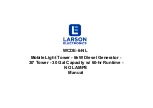
10
Section 2 – Installation
Standby Generator Set
The battery represents a risk of high short circuit
current. When working on the battery, always
remove watches, rings or other metal objects,
and only use tools that have insulated handles.
2.8.1 VENTED
BATTERIES
The electrolyte is a dilute sulfuric acid that is
harmful to the skin and eyes. It is electrically
conductive and corrosive. The following proce-
dures are to be observed:
• Wear full eye protection and protective clothing,
• Where electrolyte contacts the skin, wash it off
immediately with water,
• Where electrolyte contacts the eyes, flush thor-
oughly and immediately with water and seek
medical attention, and
• Spilled electrolyte is to be washed down with an
acid-neutralizing agent. A common practice is to
use a solution of one pound (500 grams) bicarbon-
ate of soda to one gallon (4 liters) of water. The
bicarbonate of soda solution is to be added until
the evidence of reaction (foaming) has ceased. The
resulting liquid is to be flushed with water and the
area dried.
Lead acid batteries present a risk of fire because
they generate hydrogen gas. The following pro-
cedure are to be followed:
• DO NOT SMOKE when near batteries,
• DO NOT cause flame or spark in battery area, and
• Discharge static electricity from body before touch-
ing batteries by first touching a grounded metal
surface.
Servicing of batteries is to be performed or super-
vised by personnel knowledgeable of batteries and
the required precautions. Keep unauthorized person-
nel away from batteries.
For recommended batteries, see “Specifications.”
All batteries must be at 100 percent state-of-charge
before they are installed on the generator.
When using maintenance-free batteries, it is not
necessary to check the specific gravity or electrolyte
level. Have these procedures performed at the inter-
vals specified in the “Maintenance" section. A nega-
tive ground system is used. Battery connections are
shown on the wiring diagrams. Make sure all batter-
ies are correctly connected and terminals are tight.
Observe battery polarity when connecting batteries
to the generator set.
NOTE:
Damage will result if the battery connections are
made in reverse.
2.9 PREPARATION
BEFORE
START-UP
The instructions in this section assume that the
standby generator has been properly installed, ser-
viced, tested, adjusted and otherwise prepared for
use by a competent, qualified installation contractor.
Be sure to read the “Safety Rules” on Pages 2 and 3,
as well as all other safety information in this manual,
before attempting to operate this (and related) equip-
ment.
2.9.1 PRIOR TO INITIAL START-UP
Prior to initially starting the generator, it must
be properly prepared for use. Any attempt to
crank or start the engine before it has been
properly serviced with the recommended types
and quantities of engine fluids (oil, coolant, fuel,
etc.) may result in an engine failure.
Before starting the generator for the first time, the
installer must complete the following procedures.
For follow-up maintenance information and/or ser-
vice intervals, please refer to the “Maintenance” and
“Service Schedule” sections.
2.9.1.1 Transfer Switch
If this generator is used to supply power to any elec-
trical system normally powered by an electric utility,
the National Electrical Code requires that a transfer
switch be installed. The transfer switch prevents elec-
trical backfeed between two different electrical sys-
tems. (For additional information, see the applicable
transfer switch manual for this unit.) The transfer
switch, as well as the generator and other standby
components, must be properly located and mounted
in strict compliance with applicable codes, standards
and regulations.
2.9.1.2 Fuel System
Make sure the fuel supply system to the generator (a)
delivers the correct fuel at the correct pressure and (b)
is properly purged and leak tested according to code.
No fuel leakage is permitted. See “Specifications” for
more information.
If the unit has been idle for a long period of time,
or if the fuel lines or system components have been
removed and reinstalled, the fuel system may require
bleeding to remove air from the system. Air in the
fuel system causes hard starting and rough opera-
tion. All fuel system lines must be installed and must
be tight. A loose line may show no sign of leakage, but
may draw air into the system.













































